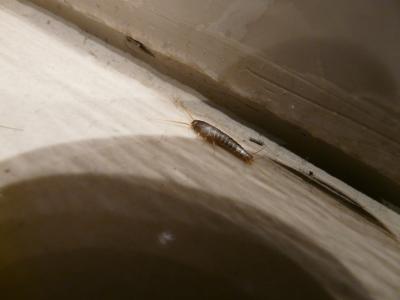Silverfish are tricky pests to deal with. They reproduce quickly and are great at hiding, which makes them tough to eliminate once they’ve made their way into your home. That’s why preventative pest control is so important. True to their name, silverfish have a silvery, fish-like appearance — and they’re definitely not something you want creeping around your home!
About Silverfish
Silverfish are small, wingless insects known for their shiny, silver-gray bodies and fast, wriggling movement, similar to the way a fish swims. While they don’t bite or spread disease, they can be a real nuisance in homes, especially in dark, damp areas like bathrooms, basements, and kitchens.
These pests feed on starchy materials and anything high in sugar, including paper, glue, books, wallpaper, and even clothing. Over time, a silverfish infestation can lead to damage to stored items and household belongings.
Silverfish are nocturnal and extremely quick, which makes them difficult to spot. If you’re noticing small holes in paper goods, yellowish stains, or catching glimpses of fast-moving bugs at night, you could be dealing with a silverfish problem.
What Do Silverfish Look Like?
Silverfish have a very distinctive look that sets them apart from other common household pests. Their name says a lot about their appearance; they’re silvery, shiny, and move with a quick, wriggling motion that resembles a fish.

Here’s how to identify a silverfish:
- Color: Silvery-gray or metallic blue, giving them a shiny appearance.
- Shape: Tear-drop shaped bodies that taper toward the back.
- Size: Typically about ½ inch to ¾ inch long.
- Antennae: Long, thread-like antennae on their head.
- Movement: They move fast and in a wiggling motion, especially when disturbed.
- Tail: Three long bristles at the rear, giving them a “three-pronged” look from behind.
Silverfish are wingless, but their speed and sleek bodies help them scurry across floors and walls with ease. They’re most often found in dark, humid places like bathrooms, attics, basements, and storage boxes.
What Are The Unique Characteristics of Silverfish?
Silverfish may be small, but they have some standout traits that make them easy to identify and surprisingly tough to deal with. Unlike many common household pests, they don’t bite or spread disease, but their physical features and survival abilities are unique.
Here’s what makes silverfish different:
- Shiny, metallic appearance: Their silver or bluish-gray color and fish-like scales give them a slick, shiny look.
- Wiggling movement: They don’t crawl like ants; they move in quick, jerky motions that resemble a swimming fish.
- No wings, but very fast: Silverfish can dart away quickly when disturbed, making them hard to catch.
- Survival specialists: They can live for weeks without food and survive in many environments, though they prefer moist areas.
- Long lifespan: Unlike many insects, silverfish can live up to 3 years, which means infestations can grow quietly over time.
- Damage without detection: They nibble on starchy household items, like books, wallpaper, and clothing, often without being seen.
What Are The Habits of Silverfish?
Silverfish have some very consistent behaviors that help them thrive indoors. Their habits not only explain how they survive, but also why they’re so commonly found in homes, especially in damp, dark areas.
Here’s what to know about silverfish habits:
- Nocturnal activity: Silverfish are most active at night, which is why they’re rarely seen during the day.
- Love of moisture: They’re drawn to humid spaces like bathrooms, kitchens, basements, and laundry rooms.
- Hiding in tight spaces: These pests slip into cracks, crevices, and behind baseboards to stay hidden and protected.
- Attracted to starch and sugar: They feed on things like glue, paper, cardboard, fabrics, and pantry goods.
- Silent invaders: Silverfish don’t make noise or leave obvious signs, so infestations can grow unnoticed for a long time.
- Consistent reproduction: Female silverfish lay eggs in hidden places regularly, allowing populations to build up quickly if left untreated.
What Are The Risks of a Silverfish Infestation?
While silverfish don’t bite, sting, or spread disease, they can still cause plenty of problems in your home, especially if the infestation is left untreated. These pests are quiet, fast, and excellent at hiding, which makes them easy to overlook until the damage is already done.
Here are the main risks of having silverfish in your home:
- Damage to personal belongings: Silverfish feed on starchy materials, which include paper, books, wallpaper, cardboard, and even photos. Over time, they can chew small holes and leave behind yellow stains.
- Contamination of stored goods: Silverfish are known to get into pantry items like flour, oats, and other grains, making food unsafe to eat.
- Damage to clothing and fabrics: They’re also attracted to natural fibers, including silk, cotton, and linen, especially if those items have starch-based residues.
- Allergy triggers: In some cases, silverfish scales and droppings can contribute to indoor allergens, especially in people with sensitivities.
- Growing infestations: Silverfish reproduce quickly and live for a long time, which means an infestation can grow and spread throughout the home before it’s even noticed.
Need help with silverfish? Our team of professional exterminators in the Phoenix area is ready to help today. Get started with Greenleaf Pest Control now!






